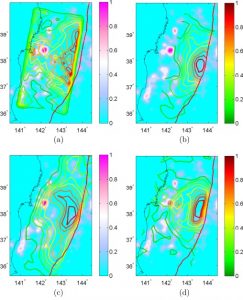Yicun Guo(1), Jiancang Zhuang(2), Naoshi Hirata(1), Shiyong Zhou(3)
(1)Earthquake Research Institute, the University of Tokyo (2) Institute of Statistical Mathematics (3) Peking University
Journal of Geophysical Research(2017), 122, 5288-5305, doi:10.1002/2017JB014064
The epidemic type aftershock sequence (ETAS) model is widely used to describe and analyze the clustering behavior of seismicity. Instead of regarding large earthquakes as point sources, the finite-source ETAS model treats them as ruptures that extend in space. Each earthquake rupture consists of many patches, and each patch triggers its own aftershocks isotropically. We design an iterative algorithm to invert the unobserved fault geometry based on the stochastic reconstruction method. This model is applied to analyze the Japan Meteorological Agency (JMA) catalog during 1964~2014. We take six great earthquakes with magnitudes >7.5 after 1980 as finite sources and reconstruct the aftershock productivity patterns on each rupture surface. Comparing results from the point-source ETAS model, we find the following: (1) the finite-source model improves the data fitting; (2) direct aftershock productivity is heterogeneous on the rupture plane; (3) the triggering abilities of M5.4+ events are enhanced; (4) the background rate is higher in the off-fault region and lower in the on-fault region for the Tohoku earthquake, while high probabilities of direct aftershocks distribute all over the source region in the modified model; (5) the triggering abilities of five main shocks become 2~6 times higher after taking the rupture geometries into consideration; and (6) the trends of the cumulative background rate are similar in both models, indicating the same levels of detection ability for seismicity anomalies. Moreover, correlations between aftershock productivity and slip distributions imply that aftershocks within rupture faults are adjustments to coseismic stress changes due to slip heterogeneity.



